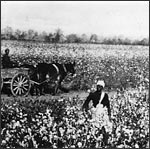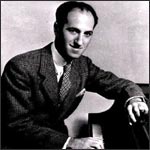








 From Shtetls and Chain Gangs
From Shtetls and Chain Gangs
The roots of the Blues lie in the music of slaves, songs sung on chain gangs, and sounds from the fields of the American South. Jewish folk music's origins are south central Europe, from the shtetls (Jewish villages formerly found in parts of Eastern Europe) of the Pale of Settlement. This was the only region in the Russian Empire from the late 18th century where Jews were allowed to live. If you listen closely to these two very different sounds from the musical traditions of these areas, you can start to hear the beginnings of popular song in this country.
 |
| A slave in a cotton field. |
When Jews began arriving in America in large numbers at the end of the 19th century, they brought with them many different kinds of traditional songs, secular and religious, with one unifying characteristic, the krecht. This wailing, sobbing sound is the element that distinguishes Jewish music.
The characteristic quality of the Blues is something different. Blues music growls. There is an instinctive quality in its intonation. Singers led the way in the development of the Blues, and instrumentalists followed. The human voice could pour over notes flexibly, and horn and string players imitated what they heard from vocalists like Bessie Smith.
At the turn of the century, both blacks and Jews were on the move by the millions, heading away from poverty and oppression in the rural South and in Europe. They were seeking a new beginning in the great cities of America's industrial north. Many ended up in impoverished neighborhoods of New York, the only places for blacks and whites to live together in an otherwise segregated society.
From Europe, Jews brought a synthesizing musical sensibility. They had been living at the intersection of multiple cultures, Jewish musicians had borrowed and combined musical ideas from many sources: Greek sailors' dances, Romanian shepherds' songs, Arabic modalities. From the South, Blacks brought a unique sound that expanded the sensual possibilities of instrumental music.
American Music and IntegrationJust as poor neighborhoods were the only places for them to live, one of the few places blacks and whites could work together was the music business. Another was left wing politics. In both places, most whites were Jews. Of course, not all Jews were involved in progressive politics. However, the majority of whites in cities attracted to progressive politics were Jews and racial justice was a core issue of the left.
 |
| Bessie Smith. (Edward Elcha) |
Jewish immigrants came to the United States knowing little of its strained race relations and history of oppression. What they knew was that the hippest music they heard was ragtime. In the age-old process of distancing themselves from the old country, they adopted the tunes of their new home as their own. However, in doing so, they changed the music and created something different and new.
Some Jewish musicians, like Tin Pan Alley founders Irving Berlin, George
Gershwin, and Harold Arlen, consciously imitated Blues-derived music.
In turn, African American musicians synthesized, used Yiddish tunes and
expressions in their songs.
Until well into the 1930's, bands were segregated, at least onstage. One
of the first musicians to break the barrier was Benny Goodman, who, at
the suggestion of his producer John Hammond, decided to play on stage
with black pianist Teddy Wilson.
 |
| George Gershwin. (AP) |
The movement toward integration under the cover of music reached its apex in 1938, when Barney Josephson opened the Caf´┐Ż Society in New York. It was the only nightclub outside of Harlem where blacks and whites could mix, and its success encouraged others to follow suit.
Following the Second World War, the musical interchange between blacks and Jews continued to redefine American popular music. There was music for pleasure: rock and roll. There was music for politics, its apotheosis being Bob Dylan and his Blues-tinged songs, and a vocal style that was a perfect balance of sob and growl.
Soundtrack of an American Century
Since the 1960's, the worlds of pop music and progressive politics have
diverged.
Relations in the music industry between blacks and Jews continue to be
reassessed. The discourse has been painful; many artists who made history
refuse to discuss it, leaving it to younger musicians to comment.
The evolution of American popular music in the 20th century combined
the optimism and energy of new immigrants with the agony that results
from racial discrimination. The music of Blacks from the south and Jews
from Europe shares these things: both are deeply emotional; both sprang
from the effort to transcend harsh environments; both seek to reach a
higher ground through musical expression. The convergence of old
worlds in the new created something that changed the sound of music
forever.
Listen
to the Audio Documentary
Hear
Music from the Show
ęCopyright 2001, WBUR
Credits | Broadcast Times | Participants | Music From The Show